Caryn
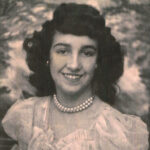
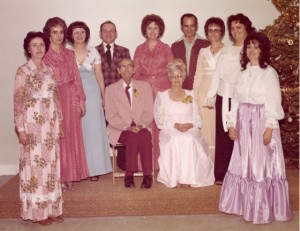 As the years go by, the number of aunts and uncles I have who are still living dwindles down. We don’t lose one or more every year, but they are slowly leaving us, and even years after they are in Heaven, I still think of them often, and especially on their birthdays. when I was a little girl, I somehow thought my Aunt Virginia Beadle was a tall (but not too tall) slim lady…and she was slim anyway. I suppose my own shortness made her seem taller, and I don’t know how tall she was in her tall days, but I know that in her latter years, she just got more and more tiny. Every time I saw her, I was amazed at how much more tiny and frail looking she
As the years go by, the number of aunts and uncles I have who are still living dwindles down. We don’t lose one or more every year, but they are slowly leaving us, and even years after they are in Heaven, I still think of them often, and especially on their birthdays. when I was a little girl, I somehow thought my Aunt Virginia Beadle was a tall (but not too tall) slim lady…and she was slim anyway. I suppose my own shortness made her seem taller, and I don’t know how tall she was in her tall days, but I know that in her latter years, she just got more and more tiny. Every time I saw her, I was amazed at how much more tiny and frail looking she  was, but she wasn’t sickly, and that was a good thing. Unfortunately, she was just getting older, and that was a bad thing.
was, but she wasn’t sickly, and that was a good thing. Unfortunately, she was just getting older, and that was a bad thing.
Aunt Virginia lived a full life, and she did so many things in her life. She worked much of her adult life…first for the telephone company, and then for the State of Wyoming. She was mom to three sons and two daughters. Her adopted son, Forest went to Heaven on July 3, 2005; and a daughter, Christy went to Heaven the day after her birth on November 20, 1967. Those were very sad events for Aunt Virginia, and I know that she is really enjoying her time with the children who went home ahead of her…as well as her husband, Uncle Bill Beadle who went home ahead of her too. Aunt Virginia was extremely saddened by every loss, but strong woman that she was, she persevered. That made her an inspiration to many…especially her children…and many of her nieces and nephews.
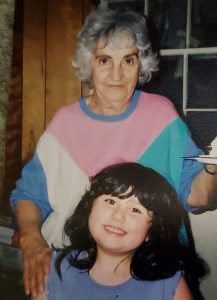
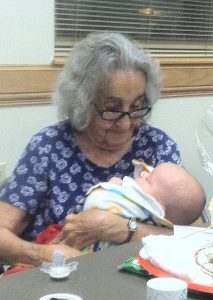 The Byer girls were a beautiful bunch, and Aunt Virginia was no exception. I always thought of her as very sophisticated. Maybe it was because of how she dressed for the jobs she held. In those days, dresses were the norm…especially at work, and Aunt Virginia always looked stunning. I remember looking at her as a little girl and thinking how pretty she was. I think I always wanted to “dress up” like she did. She was very pretty, but more important than her beauty, was her sweet disposition. She was always thoughtful and kind, and that endeared her to many people…both at work and in her daily life. She was soft-spoken and kind, and we all loved her. Today would have been Aunt Virginia’s 92nd birthday. Happy birthday in Heaven, Aunt Virginia. We love and miss you very much.
The Byer girls were a beautiful bunch, and Aunt Virginia was no exception. I always thought of her as very sophisticated. Maybe it was because of how she dressed for the jobs she held. In those days, dresses were the norm…especially at work, and Aunt Virginia always looked stunning. I remember looking at her as a little girl and thinking how pretty she was. I think I always wanted to “dress up” like she did. She was very pretty, but more important than her beauty, was her sweet disposition. She was always thoughtful and kind, and that endeared her to many people…both at work and in her daily life. She was soft-spoken and kind, and we all loved her. Today would have been Aunt Virginia’s 92nd birthday. Happy birthday in Heaven, Aunt Virginia. We love and miss you very much.

 The cold war was one of the strangest times in world history. It wasn’t a war…exactly, but a period of geopolitical tension between the United States and the Soviet Union and their respective allies, the Western Bloc, and the Eastern Bloc, which began following World War II. While the war did not really “act” like a war, at least 389 soldiers were killed in the line of duty, as estimated by the American Cold War Veterans. These casualties were the result of planes being shot down by the Communist forces of the Soviet Union. One such plane was an American Navy P2V-3W was shot down near Vladivostok over the Sea of Japan by Soviet forces in November of 1951. The P2V-3W exploded off the coast, and the crew of 10 American soldiers was reported as missing. The Soviets accused the crew of gathering intelligence, and the Americans claimed that the mission was related to weather reconnaissance. The truth may never be really known. There were many other hazards that Americans were exposed to during the conflict. An estimated 400,000 people were subject to harm from toxins, which killed more than half of those who were exposed to them. Several thousand soldiers also lost their lives during these years in training accidents and friendly-fire incidents. So, while there were never any “battles” there were losses.
The cold war was one of the strangest times in world history. It wasn’t a war…exactly, but a period of geopolitical tension between the United States and the Soviet Union and their respective allies, the Western Bloc, and the Eastern Bloc, which began following World War II. While the war did not really “act” like a war, at least 389 soldiers were killed in the line of duty, as estimated by the American Cold War Veterans. These casualties were the result of planes being shot down by the Communist forces of the Soviet Union. One such plane was an American Navy P2V-3W was shot down near Vladivostok over the Sea of Japan by Soviet forces in November of 1951. The P2V-3W exploded off the coast, and the crew of 10 American soldiers was reported as missing. The Soviets accused the crew of gathering intelligence, and the Americans claimed that the mission was related to weather reconnaissance. The truth may never be really known. There were many other hazards that Americans were exposed to during the conflict. An estimated 400,000 people were subject to harm from toxins, which killed more than half of those who were exposed to them. Several thousand soldiers also lost their lives during these years in training accidents and friendly-fire incidents. So, while there were never any “battles” there were losses.
Because of the Nazi loss in World War II, and the surrender in 1945, the nation’s capital, Berlin, was divided into four sections, with the Americans, British, and French controlling the western region, and the Soviets controlling the eastern region. The three western sections came together as the Federal Republic of Germany (West Germany). East Germany became the German Democratic Republic in October of that same year. With tensions mounting, the border between the two new countries was closed in 1952, and by the following year East Germans were prosecuted if they left their country without permission. The situation grew worse when in August 1961, the Berlin Wall was erected by the East German government to prevent its citizens from escaping to the West. People were trying to escape every day, and between 1949 and night the wall went up, an estimated 2.5 million East Germans fled to the West.
By the time President Ronald Reagan was in office, the Cold War had started to really get old. Something had to change, and Reagan was determined to do something to stop the feuding. Like all presidents, part of keeping the people informed on matters of importance is making speeches, and on June 12, 1987, President Reagan made one of his most famous Cold War speeches, when he issued a challenge to Soviet Leader Mikhail Gorbachev to “tear down” the Berlin Wall. With the Berlin Wall behind him, Reagan said, “There is one sign the Soviets can make that would be unmistakable, that would advance dramatically the cause of freedom and peace.” He then called upon his Soviet counterpart: “Secretary General Gorbachev, if you seek peace—if you seek prosperity for the Soviet Union and Eastern Europe—if you seek liberalization: come here, to this gate. Mr. Gorbachev, open this gate. Mr. Gorbachev, tear down this wall.” The speech was also intended to ask Gorbachev to undertake serious arms reduction talks with the United States.
Many people thought that Reagan’s speech as a dramatic appeal to Gorbachev to renew negotiations on nuclear arms reductions, but it was also a reminder that despite Gorbachev’s public statements about a new 
 relationship with the West, the United States also wanted to see action taken to lessen Cold War tensions. The people of East Berlin just wanted freedom, and two years later, on November 9, 1989, East and West Germans got their way when the people broke down the infamous wall between East and West Berlin. Germany was officially reunited on October 3, 1990.
relationship with the West, the United States also wanted to see action taken to lessen Cold War tensions. The people of East Berlin just wanted freedom, and two years later, on November 9, 1989, East and West Germans got their way when the people broke down the infamous wall between East and West Berlin. Germany was officially reunited on October 3, 1990.
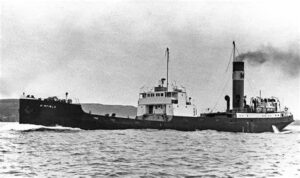 Shipwrecks have always intrigued me. Of course, you always hope that everyone got out alive, but the unfortunate truth is that usually that is not the case. Most shipwrecks sink to the bottom of the ocean, and often it takes years to even fins them. That was not the case with the SS Ayrfield, as well as a couple of other ships that “sank” in plain sight.
Shipwrecks have always intrigued me. Of course, you always hope that everyone got out alive, but the unfortunate truth is that usually that is not the case. Most shipwrecks sink to the bottom of the ocean, and often it takes years to even fins them. That was not the case with the SS Ayrfield, as well as a couple of other ships that “sank” in plain sight.
The SS Ayrfield was built in 1911, and it really didn’t sink. The plan was for it to be decommissioned and scrapped. The SS Ayrfield’s fate was sealed. She had served faithfully for 60 years, having been built in Scotland and sailed to Australia. She was used as a transport supply boat to US troops in the Pacific in World War II, and then retired. She was then used to run coal from Newcastle to Sydney for the rest of her working life. She was finally sent to Homebush Bay, which is where the old marine wrecking yards were. Ships didn’t come back from Homebush Bay. That feels a little sad to me. The plan was to scrap the ship, but that wasn’t exactly what happened.

As the ships sat rusting, waiting for the final scrapping, somehow it just didn’t happen. As they sat there, their insides slowly became completely colonized by mangrove trees. Branches and bark replaced the railings and ropes. The trees have taken root and as they have grown, they have created a giant leafy dome over the slowly disappearing hull. The ships have become known as the “Floating Forest” for obvious reasons, and just like a forest, their beauty is amazing.
Homebush Bay is actually home to the remains of the SS Ayrfield, as well as her neighbors, SS Mortlake Bank, steam tugboat SS Heroic, and boom defense vessel HMAS Karangi, all of which were broken up in the early 1970s. It is thought that there may be as many as seven ships in the bay. They now lie near the south-western shore of the bay, and they are completely visible from land and the hundreds of homes just a short distance away. Some people consider the ship graveyard, a little creepy, but since these weren’t sinkings with a loss of life, I think they are very cool.
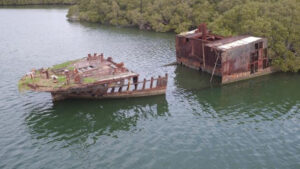
Unfortunately, during the 20th century, Homebush Bay was a heavy industry center, home to many industrial facilities. When industrial operations scaled down, the bay became a dumping ground for a large range of unwanted material…from waste to broken up ships, even toxic industrial waste. Union Carbide had manufactured chemicals, including Agent Orange, on the site and dioxins produced as a byproduct were buried in landfill or left in drums. The area has been in the process of being reclaimed, but fishing is prohibited, and I would not want to go in the water. It just doesn’t seem safe…even if it is beautiful.
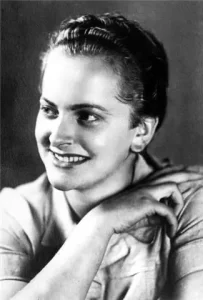
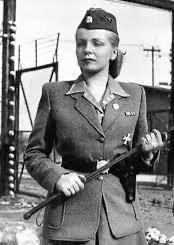 Raised by farming parents, who hated Nazis and all that they stood for, didn’t stop Irma Grese from wanting to join the Bund Deutscher Mädel or League of German Girls. Nevertheless, her father forbade it. Irma Elisabeth Ilse Ida Grese was born to Berta Grese and Alfred Grese, both dairy workers, on October 7, 1923. She was the third of five children (three girls and two boys). While Irma was an “angelic” looking girl with blond hair and blue eyes, there was something else living behind those eyes, a determination to get what she wanted…no matter the cost. In 1938 at the age of 15, Irma left school and worked as an assistant nurse in the sanatorium of the SS.
Raised by farming parents, who hated Nazis and all that they stood for, didn’t stop Irma Grese from wanting to join the Bund Deutscher Mädel or League of German Girls. Nevertheless, her father forbade it. Irma Elisabeth Ilse Ida Grese was born to Berta Grese and Alfred Grese, both dairy workers, on October 7, 1923. She was the third of five children (three girls and two boys). While Irma was an “angelic” looking girl with blond hair and blue eyes, there was something else living behind those eyes, a determination to get what she wanted…no matter the cost. In 1938 at the age of 15, Irma left school and worked as an assistant nurse in the sanatorium of the SS.
As I looked at Irma’s life, I wondered how she could have possibly gone in such a horrific direction with the parents she had. Then, I realized that in Germany in the 1930s, parents were quickly losing the right to raise their own children. They had no control over the education process, and in fact, the Nazi regime was quickly making the children believe that their parents were uneducated and stupid. The Nazi regime backed the “right” of the children to choose their destiny…provided it was “in sync” with the Nazi agenda. In 1936, her mother died by suicide after drinking hydrochloric acid following the discovery of Alfred’s affair with the local pub owner’s daughter. This might have contributed to Irma’s coming disobedience.
Despite Alfred, her farmer father’s objections, Irma was determined to join the Nazi party, because of the opportunity to become a nurse that they were offering her. She began studying at Hohenlychen, a SS hospital as an assistant nurse, in 1939. During her time there, she worked with Dr Karl Gebhardt, who performed medical experiments on patients, but he was unsuccessful at nursing and moved on to be a machinist. Once she was 18, she joined the Aufseherinnen SS and, after passing the necessary examinations, entered training at Ravensbrück. At Ravensbrück, Irma trained for three weeks (the program was a month, but Irma was an eager learner, and so went through it in three weeks). It is believed that she also had numerous relationships with male officers, which may have helped to “cut down” on her education time.
In 1943, Irma was sent to Auschwitz-Birkenau to guard female prisoners and was promoted the following year to the second-highest position within the Aufseherinnen at the camp. Due to her transfer, Irma had a falling out with her father, as he had been vehemently opposed to her joining the SS entourage, and he expelled her from the house. She oversaw 30,000 female prisoners at Auschwitz-Birkenau, and she was known to be brutal. The inmates at Auschwitz nicknamed her The Hyena of Auschwitz…probably because of the fact that she delighted in their pain. She wore heavy boots, carried a whip, and a pistol. While her appearance was that of a kindly person, she was known to have an affinity for kicking and beating prisoners, walking around camp with two hungry dogs trained to kill, and generally inflicting pain upon anyone who committed the slightest offense. She took pleasure in having the camp doctor operate on prisoners without anesthetic and, according to Dr Gisella Perl (the woman who performed an abortion for Irma on one occasion), she enjoyed the “sight of this human suffering. Her tense body swung back and forth in a revealing, rhythmical motion. Her cheeks were flushed and her wide-open eyes had the rigid, staring look of complete sexual paroxysm.”
Irma was transferred to Ravensbrück in January 1945, before being sent to Bergen-Belsen in March…where 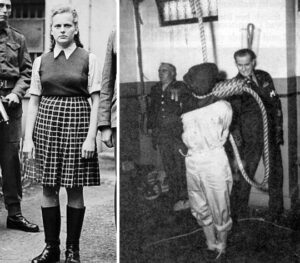
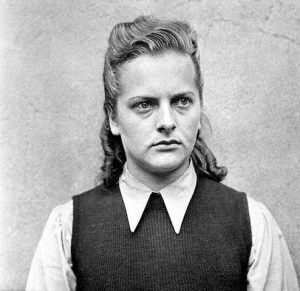 her brutal behavior continued. She enjoyed torturing the women under her control. She made women kneel for long periods of time, or hold large rocks over their heads, or stand in the snow or rain for hours. She felt no pity. Irma was captured by British soldiers in April 1945 and put on trial soon after. She claimed that she was just following orders and serving the state. She showed no remorse…even as she was sentenced to hang. Irma was hanged on December 13, 1945. At the age of 22, she was the youngest Nazi criminal to be executed.
her brutal behavior continued. She enjoyed torturing the women under her control. She made women kneel for long periods of time, or hold large rocks over their heads, or stand in the snow or rain for hours. She felt no pity. Irma was captured by British soldiers in April 1945 and put on trial soon after. She claimed that she was just following orders and serving the state. She showed no remorse…even as she was sentenced to hang. Irma was hanged on December 13, 1945. At the age of 22, she was the youngest Nazi criminal to be executed.

 My niece, Kayla Stevens is a great mom to the daughter that she and my nephew, Garrett Stevens share. Elliott will be 4 years old on August 3rd, and she will become a big sister just a few days from now. The really nice thing for Kayla with this new baby is that she works from home. While Elliott goes to daycare, because Kayla’s job is such that having an older child at home during working hours is not feasible, having the baby at home will be ok, probably for the first year or so anyway. That will be a wonderful bonding time for the two of them too. By then, Elliott will be in school, so Kayla and Garrett will still only have to have one child in daycare, which is nice, considering the cost of daycare. We are all excited for their coming little addition, and they are busily getting ready.
My niece, Kayla Stevens is a great mom to the daughter that she and my nephew, Garrett Stevens share. Elliott will be 4 years old on August 3rd, and she will become a big sister just a few days from now. The really nice thing for Kayla with this new baby is that she works from home. While Elliott goes to daycare, because Kayla’s job is such that having an older child at home during working hours is not feasible, having the baby at home will be ok, probably for the first year or so anyway. That will be a wonderful bonding time for the two of them too. By then, Elliott will be in school, so Kayla and Garrett will still only have to have one child in daycare, which is nice, considering the cost of daycare. We are all excited for their coming little addition, and they are busily getting ready.
Kayla is social worker with the Veterans Administration in Sheridan. I can’t think of a more caring person for our veterans. She has found that her work with the Veterans Administration has truly been fulfilling. When she first started working as a social worker, she was on the substance abuse team at the Wyoming Mental Health Team, which I think was probably the hardest of her positions. Later she was moved to the child and family team, which I really thought she would stay with. I think the Lord just had better plans for her, and her work with the Veteran’s Administration has shown that to be true. Our veterans deserve caring people, like Kayla, to help with their needs,
Kayla’s may life work, however, will always be her family. She loves spending time with her daughter and husband. They go to the park, and Elliott delights them with her antics. She is a smart little girl and is always showing them what she can do. They have her in swimming and gymnastics, and she is always wowing them with her tricks. Being a mom is probably the greatest blessing Kayla has ever received, and becoming a mom 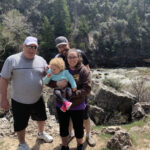
 again is just as awesome. I can’t believe how close the date is getting, and I can’t wait to meet baby Stevens number two. I love that Kayla is so good about sending me videos and pictures of Elliott’s life and activities. It is hard when these kids live in a different town, but she makes it easy to be a part of their lives…and I very much appreciate that. Today is Kayla’s birthday. Happy birthday Kayla!! Have a great day!! We love you!!
again is just as awesome. I can’t believe how close the date is getting, and I can’t wait to meet baby Stevens number two. I love that Kayla is so good about sending me videos and pictures of Elliott’s life and activities. It is hard when these kids live in a different town, but she makes it easy to be a part of their lives…and I very much appreciate that. Today is Kayla’s birthday. Happy birthday Kayla!! Have a great day!! We love you!!
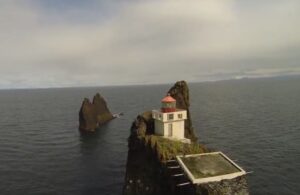
 In the years before GPS (Global Positioning System), lighthouses were a vital part of keeping ships off of the shore, rocks just below the surface, and islands. While necessary, lighthouses were not always easy to build. Of course, a lighthouse that sat on the shoreline of a coast was a fairly simple build, but one that sat on the top of a dangerous rock outcropping was more difficult, especially if the rocks were very tall and hard to access, like the Pridrangaviti Lighthouse in the Westman Islands of Iceland.
In the years before GPS (Global Positioning System), lighthouses were a vital part of keeping ships off of the shore, rocks just below the surface, and islands. While necessary, lighthouses were not always easy to build. Of course, a lighthouse that sat on the shoreline of a coast was a fairly simple build, but one that sat on the top of a dangerous rock outcropping was more difficult, especially if the rocks were very tall and hard to access, like the Pridrangaviti Lighthouse in the Westman Islands of Iceland.
The Pridrangaviti Lighthouse was built in 1938, right before the onset of World War II. Its construction was by 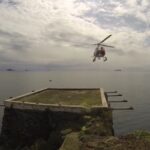 no means an easy task. Construction workers had to scale the cliff to reach the place where they were to lay the lighthouse groundwork. This mean facing slick rocks, rain, winds, and even heavy surf. One misstep would lead to their death on the rocks and icy North Atlantic Ocean below. Nevertheless, the task was eventually finished, and the effect is quite beautiful.
no means an easy task. Construction workers had to scale the cliff to reach the place where they were to lay the lighthouse groundwork. This mean facing slick rocks, rain, winds, and even heavy surf. One misstep would lead to their death on the rocks and icy North Atlantic Ocean below. Nevertheless, the task was eventually finished, and the effect is quite beautiful.
The lighthouse warns passing ships of a cluster of slender rock pillars that jut out from the ocean’s surface. The pillars look like fingers stretching toward the sky, and they are located miles away from civilization. The lighthouse looks like a colorful speck on top of the largest pillar. The tiny, red-roofed lighthouse is quite likely one of the loneliest lighthouses in the world, and I don’t think I would want to be the person who had the job of manning it. The lighthouse is the only thing on the rock, and so you would likely be there for at least a month at a time before it would be feasible to leave.
Repairs were a big issue as well…at least until modern times. These days, when repairs are needed, supplies 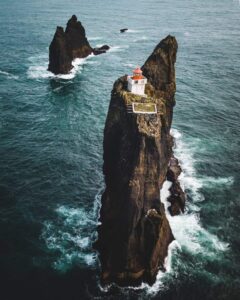
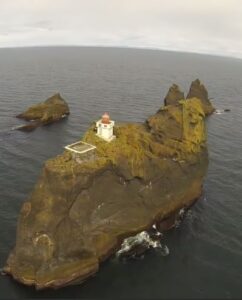 and workers can be helicoptered in. And these days, the rock sports a helicopter pad for any visitors who might go there. You could also get there by boat and go rock climbing to reach the top, but anyone who goes must know that visiting the Pridrangaviti lighthouse is a dangerous endeavor. One wrong step, and any unsuspecting explorers just may find themselves going for an unplanned swim with the killer whales that like to hang out in the waves below. Nevertheless, just imagine being able to go and visit such a lighthouse. I’m not a rock climber, so I don’t know about climbing up, but to helicopter in and be able to explore the lighthouse and the grounds…yep, that would be very cool.
and workers can be helicoptered in. And these days, the rock sports a helicopter pad for any visitors who might go there. You could also get there by boat and go rock climbing to reach the top, but anyone who goes must know that visiting the Pridrangaviti lighthouse is a dangerous endeavor. One wrong step, and any unsuspecting explorers just may find themselves going for an unplanned swim with the killer whales that like to hang out in the waves below. Nevertheless, just imagine being able to go and visit such a lighthouse. I’m not a rock climber, so I don’t know about climbing up, but to helicopter in and be able to explore the lighthouse and the grounds…yep, that would be very cool.
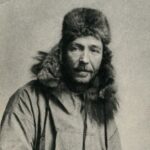
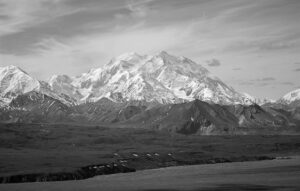 As a hiker, I can relate to the draw of a mountain peak, but I was never one to do the winter-ice-climbing-up-a-solid-rock-face type of hiker. I like trail hiking personally, but there are many people who would disagree with me on that. One such hiker/climber was Hudson Stuck, an Alaskan missionary, who on June 7, 1913, led the first successful ascent of Denali…also known as Mount McKinley, before they changed the name. Denali, at 20,320 feet is the highest on the American continent. In fact, there are planes that don’t fly that high…small planes, but nevertheless, they don’t go that high, and would have to fly around Denali.
As a hiker, I can relate to the draw of a mountain peak, but I was never one to do the winter-ice-climbing-up-a-solid-rock-face type of hiker. I like trail hiking personally, but there are many people who would disagree with me on that. One such hiker/climber was Hudson Stuck, an Alaskan missionary, who on June 7, 1913, led the first successful ascent of Denali…also known as Mount McKinley, before they changed the name. Denali, at 20,320 feet is the highest on the American continent. In fact, there are planes that don’t fly that high…small planes, but nevertheless, they don’t go that high, and would have to fly around Denali.
Not crazy enough to try Denali solo, Stuck recruited Harry Karstens, a respected guide, to join his expedition as co-leader. Other members were Walter Harper and Robert G Tatum, both 21, and two student volunteers from the mission school, John Fredson and Esaias George. They departed from Nenana on March 17, 1913. They reached the summit of Denali on June 7, 1913…nearly three months later. Harper, who was of mixed Alaska Native and Scots descent, reached the summit first. Fredson, who was just 14, acted as their base camp manager, hunting caribou and Dall sheep to keep them supplied with food.
There is snow on the mountain year-round, and the air up there is thin, requiring some climbers to bring oxygen. Experienced climbers might be able to climb Denali without oxygen, but sometimes, no matter how fit the body, it can fall victim to the effects of low oxygen…fatigue, hyperventilation, fainting, or worse. So, whether it is needed or not, oxygen is a good idea to have on the trek.
Stuck, who was born in London on November 4, 1863, is an accomplished amateur mountaineer. Mountain climbing, like hiking is an addictive passion, once it takes hold of a person. The feeling you get when you are out there, pushing yourself to new heights or longer hikes, simply can’t be matched in any gym. After moving to the United States, in 1905 Stuck became archdeacon of the Episcopal Church in Yukon, Alaska. His treks across Alaska’s difficult terrain were to preach to villagers and establish schools. His climbing of Denali was more a personal goal than a church oriented one. Stuck was an adventure-seeker, and it was that spirit that drove him to higher heights in every area of his life. And it was that spirit that drove him to the mountain tops…maybe to worship God there too. He was a missionary, after all.
Mount McKinley National Park was established as a wildlife refuge in 1917. Harry Karstens served as the park’s first superintendent. In 1980, the park was expanded and renamed Denali National Park and Preserve. 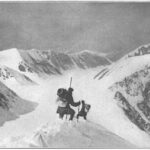
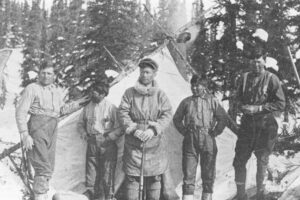 Encompassing 6 million acres, the park is larger than Massachusetts. In 2015, the mountain was officially renamed Denali. Hudson Stuck died of bronchial pneumonia at Fort Yukon, in his beloved Alaska on October 10, 1920. He was 56 years old. At his request, Stuck, still a British citizen is buried in the local cemetery at Fort Yukon. Today, over 1,000 hopeful climbers attempt to scale Denali each year, with about half of them successfully reaching their goal.
Encompassing 6 million acres, the park is larger than Massachusetts. In 2015, the mountain was officially renamed Denali. Hudson Stuck died of bronchial pneumonia at Fort Yukon, in his beloved Alaska on October 10, 1920. He was 56 years old. At his request, Stuck, still a British citizen is buried in the local cemetery at Fort Yukon. Today, over 1,000 hopeful climbers attempt to scale Denali each year, with about half of them successfully reaching their goal.
 Captain Leonard Treherne “Max” Schroeder Jr looked out over the choppy water between the landing craft he was on and the shores of their destination…the beaches of Normandy, France. The beaches had been given code names, to protect the mission…Utah, Omaha, Gold, Juno, and Sword; the operation was code named Overlord. The beach ahead of Schroeder had been code named Utah. Along the hills behind the beach were many German bunkers, with armed German snipers hiding inside of them. Schroeder knew they were just waiting for them to step onto the beach before the snipers would open fire.
Captain Leonard Treherne “Max” Schroeder Jr looked out over the choppy water between the landing craft he was on and the shores of their destination…the beaches of Normandy, France. The beaches had been given code names, to protect the mission…Utah, Omaha, Gold, Juno, and Sword; the operation was code named Overlord. The beach ahead of Schroeder had been code named Utah. Along the hills behind the beach were many German bunkers, with armed German snipers hiding inside of them. Schroeder knew they were just waiting for them to step onto the beach before the snipers would open fire.
Schroeder was about to find out firsthand, just how bad this day was going to be. In fact, he was the first American soldier whose feet hit the sand on the beach at Normandy on D-Day…so, while his men were right behind him, he would experience this horrific battle at its inception. I have wondered just how they knew that he was first amid all that chaos, but it is a documented fact. Operation Overlord was pivotal in the United States’ overall success, but it was also extremely bloody, with great loss of life. While every life lost was horrific, the men who stormed the beaches of Normandy that day were willing to give their lives for a 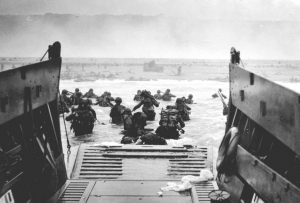 cause that they felt was essential…and I have so much respect for each and every one of them. Captain Schroeder led his team of men onto the beach…along with thousands of others…and managed to get them to their secured location. Nevertheless, during the mission, he was shot twice by German snipers. Once the mission was accomplished and his men were where they needed to be, Captain Schroeder passed out from his injuries.
cause that they felt was essential…and I have so much respect for each and every one of them. Captain Schroeder led his team of men onto the beach…along with thousands of others…and managed to get them to their secured location. Nevertheless, during the mission, he was shot twice by German snipers. Once the mission was accomplished and his men were where they needed to be, Captain Schroeder passed out from his injuries.
Schroeder woke up at an aid station on the beach, with medics taking care of his wounds so he could be transported to an army hospital in England. While in England, he recovered and had a lot of time to read all about his role in the successful mission…in many papers. I don’t know if he realized that his had been such a pivotal role in the battle, but it had. At the time, I doubt if he thought he would ever see that beach again, but in 1994, Schroeder revisited the beach at Normandy as a guest of the French 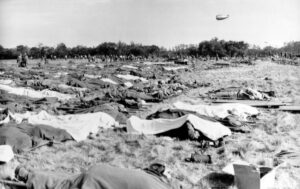 government. It was an amazing ceremony to pay homage to his heroic efforts that helped turn the tide for the Allies in World War II. It was an honor he had given no thought to as he looked out at that beach on that long ago June 6, 1944…but, an honor that he had earned along with all the other men who fought, and the many who had died. I’m sure those who gave all, were thankful that some made it home and managed to live a long life of liberty. Captain Leonard “Max” Schroeder, who was born on July 16, 1918, in Linthicum Heights, Maryland, passed away from emphysema early on the morning of May 26, 2009, in Largo, Florida at the age of 90.
government. It was an amazing ceremony to pay homage to his heroic efforts that helped turn the tide for the Allies in World War II. It was an honor he had given no thought to as he looked out at that beach on that long ago June 6, 1944…but, an honor that he had earned along with all the other men who fought, and the many who had died. I’m sure those who gave all, were thankful that some made it home and managed to live a long life of liberty. Captain Leonard “Max” Schroeder, who was born on July 16, 1918, in Linthicum Heights, Maryland, passed away from emphysema early on the morning of May 26, 2009, in Largo, Florida at the age of 90.
 Some heroes are forever unknown, and the hero of Tiananmen Square remains unknown to this day. I’m not sure how they can manage never to tell anyone about their heroic act, but then in 1989 Bejing, China, being able to keep your mouth shut was tantamount to staying alive.
Some heroes are forever unknown, and the hero of Tiananmen Square remains unknown to this day. I’m not sure how they can manage never to tell anyone about their heroic act, but then in 1989 Bejing, China, being able to keep your mouth shut was tantamount to staying alive.
The summer of 1989 found Tiananmen Square in Bejing overtaken with pro-democracy protestors…a situation that the communist government was not happy about. Students, workers, soldiers, and teachers had joined together in peaceful protest, seeking democracy, freedom of the press, and freedom of speech. As the protests progressed, they were joined by more, and more…and still more people. At the height of the protest, an estimated one million people were milling around in the square, and their efforts were becoming known worldwide. In fact, the world was becoming inspired by the efforts of the protestors.
The Chinese government, however, was becoming highly agitated by what was going on, because they felt like they were losing control. So, on June 4, the Chinese government cracked down on those protests in the most horrific way. They sent in armed military and tanks. The inevitable result was that the government killed hundreds, and even thousands of protestors, even shooting them in the back as they were running away.
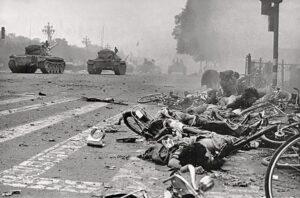
The killing continued into the next day, and just after noon on June 5 a line of eighteen tanks began rolling down Avenue of Eternal Peace. The tanks, representative of a corrupt government power, came lumbering down the street…impenetrable, unstoppable, and fully able to squash a person like a bug. The show of force continued its parade down the Avenue, toward Tiananmen Square…until one lone man stood in their way. The unknown man, dressed in a simple white shirt and black pants, holding two shopping bags, strode into the Avenue and stood directly in front of the lead tank. Amazingly, it stopped. Then the tank moved right, but the unknown man countered. Then it moved left, and he countered again. The standoff drew national attention, and the unknown man became known as “Tank Man.” The interaction lasted just a few minutes, it proved that one “everyday person” can accomplish a lot, by standing up to tyranny. One report suggested that he was the son of factory workers…a blue-collar guy growing up in a blue-collar family in a blue-collar neighborhood. And because of censorship restrictions in China, he may not even know about the images of him, or that Time Magazine named him one of the century’s “top revolutionaries.” The reality is that he wasn’t a revolutionary…at least not in the sense that he went out and fought with the resistance. He was just a guy who saw something that was horribly wrong and decided that it was enough!! His stand said simply, “No More!!”
This everyday citizen managed, single-handedly to stop the killing that day, and he intended to do it even if it  cost him his life. That is inspiring, because it tells us that if we see something wrong and decide to take action, we too can change the world. If we sit idly by and do nothing to stop tyranny, then we are no better than those who are bringing tyranny.
cost him his life. That is inspiring, because it tells us that if we see something wrong and decide to take action, we too can change the world. If we sit idly by and do nothing to stop tyranny, then we are no better than those who are bringing tyranny.
We are seeing movements just like this one man since the 2020 election. People who have never run for office before, suddenly are. People are showing up at school board meetings, city council meeting, and other such governmental meetings. People are taking a stand and proving that we are a voice to be reconned with, and we will not be bullied anymore.

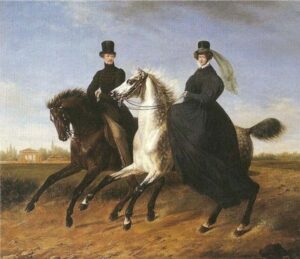 Most of us have seen strange events, designed to be something no one else has done. Things like getting married in a hot air balloon, or during a skydive, or even on horseback. And speaking of horseback…how about dining on horseback. I know, it seems strange, unless maybe you are a kid like my grandnephew, Bowen Parmely, who fully enjoys a popsicle on the back of a horse. While that is a bit unusual, it is not the strangest incidence of dining on horseback.
Most of us have seen strange events, designed to be something no one else has done. Things like getting married in a hot air balloon, or during a skydive, or even on horseback. And speaking of horseback…how about dining on horseback. I know, it seems strange, unless maybe you are a kid like my grandnephew, Bowen Parmely, who fully enjoys a popsicle on the back of a horse. While that is a bit unusual, it is not the strangest incidence of dining on horseback.
During the Gilded Age (1870 – 1900), everything was elaborate…for the very wealthy, that is. From estates that were bigger and more ornate and elaborate than many castles, to elaborate train cars, to dining on horseback…really?? How did that fit in with the extravagance of the other things? Normally, during the Gilded Age, meals were elaborate affairs and almost always held indoors. However, there were a few rather strange exceptions. The point of the Gilded Age and the very wealthy people who championed it was that everything had to be outlandish. It had to have a wow factor, and maybe even a shock factor. In fact, the whole point was to shock the people with the very richness of everything they were seeing, as well as the shock of its monetary extravagance.
So, how do you make dining on horseback into something elaborate, elegant, expensive, and rich? Obviously, outlandish was easy on this one. Remember that paper plates didn’t exist then, and the very idea of the ultra-wealthy people eating a fancy dinner with their fingers…well, it is outlandish, I guess. Most meals involving the very wealthy, involve several courses, so just imagine devouring those endless, rich courses, while trying to steady not only the horse, but the China dishes, crystal, and silver too!!
While everyone at the dinners were treated like millionaires, including the horses, the whole affair must have had some rather unpleasant components to it too. Never mind the fact that you are trying to juggle plates, cups, and silverware while on horseback, but consider the smells in the room. The food smelled delicious, I’m sure, but you cannot keep a horse from doing what horses do, so in addition to waiters, were there also stable boys in attendance. And as for the waiters, I’m quite sure it was necessary to watch where they walked…very carefully. The last thing they needed was to slip on a pile of manure and land on the floor, after throwing the food intended for a guest to eat, all over said guest. The horses were encouraged to stand still and behave, by being provided with their own individual bags of oats. I’m sure that helped, but it would still be very hard to stand perfectly still, especially since these horses weren’t previously trained for a life as a piece of furniture.
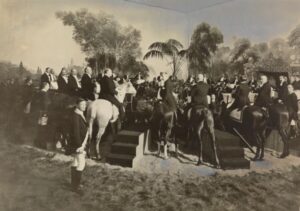
One such dinner was hosted by millionaire C K G Billing and was held at a swanky New York restaurant. Now just imagine having all those horses inside a restaurant. It would take a week to clean up afterward, I’m sure, and all of this came at an enormous cost. Billing’s bill came to $50,000, an amount unimaginable to most people in the world, but for Billing…well, he was just showing off! As for the guests…I’m sure it was considered a once-in-a-lifetime occasion, or at the very least, I’m sure they hoped it would only be a once-in-a-lifetime event. Who in their right mind would want to repeat such a dinner? Certainly not me!! And I venture to say, these guests didn’t either.

